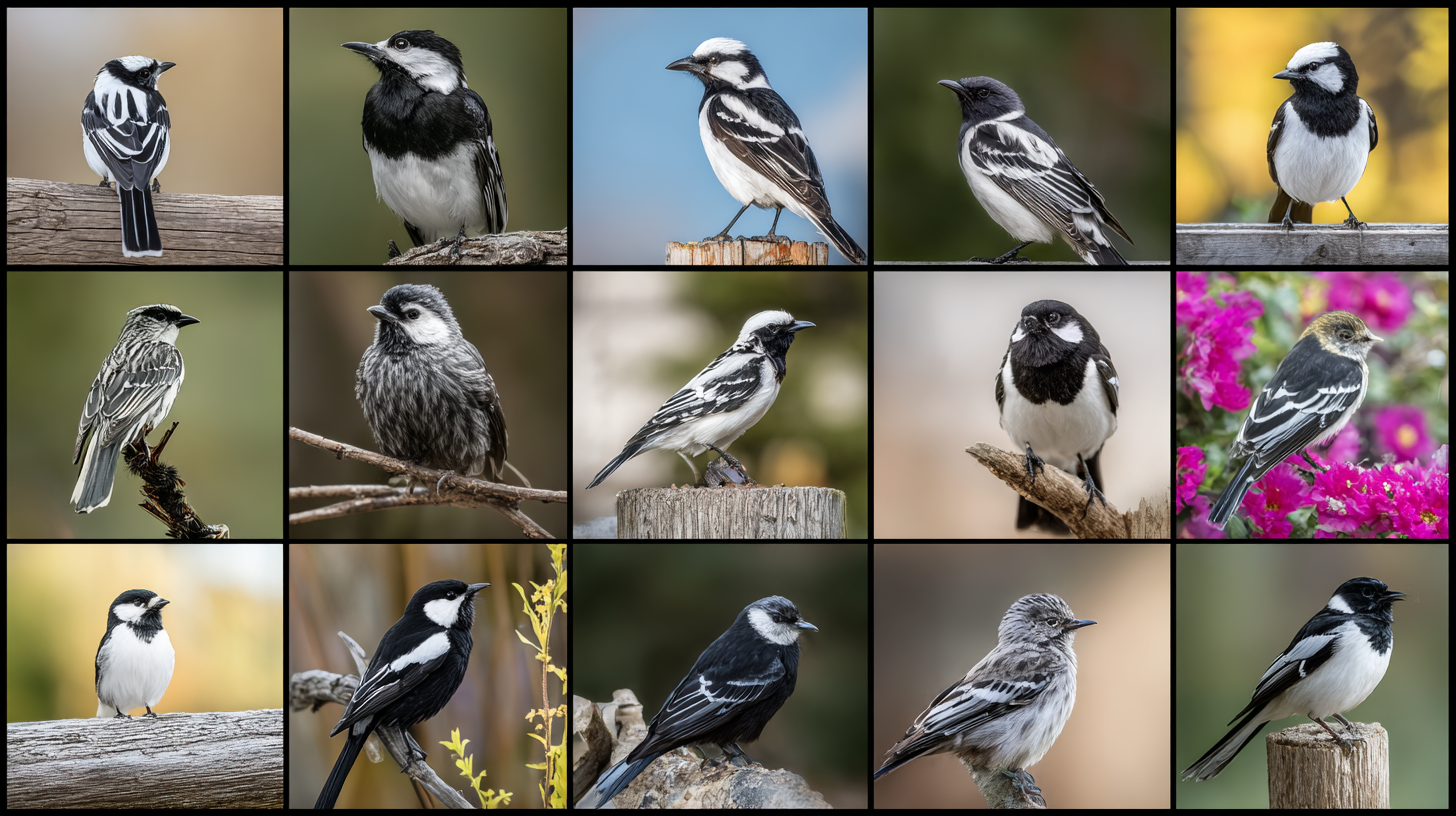Discover 9 striking black and white birds you can spot in your backyard! Learn identification tips, behaviors, and how to attract these beautiful species. Complete guide for bird lovers.
Table of Contents
Have you ever noticed those distinctive black and white birds flitting around your backyard? These monochromatic beauties add charm and character to gardens across North America, catching the eye with their bold contrast against greenery. From the tiny chickadee to the impressive magpie, black and white birds represent some of nature’s most elegant designs. In this comprehensive guide, we’ll explore nine striking black and white birds you can spot right in your own backyard, helping you identify and appreciate these remarkable feathered visitors.
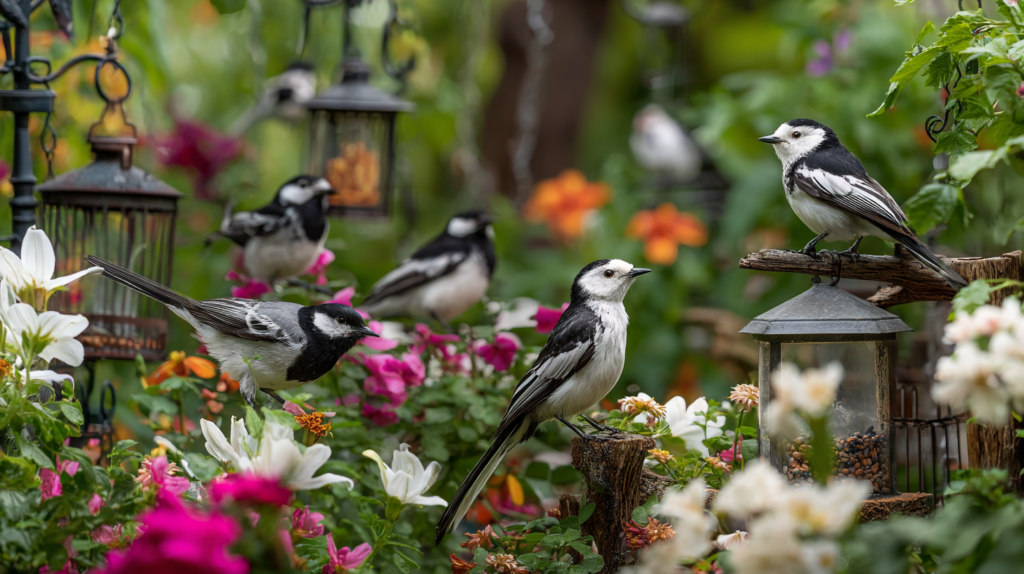
Why Black and White Birds Stand Out in Your Backyard
Before diving into specific species, it’s worth understanding why black and white birds are so visually striking. The high-contrast coloration serves multiple evolutionary purposes:
- Effective communication: The stark contrast makes these birds more visible to potential mates.
- Predator confusion: The pattern can create visual illusions that make it harder for predators to judge movement and distance.
- Temperature regulation: Black feathers absorb heat while white feathers reflect it, helping birds manage body temperature.
- Species identification: The distinct patterning helps birds recognize members of their own species.
According to Dr. Melissa Caughey, ornithologist at Cornell University, “Black and white patterning in birds is one of nature’s most successful color schemes, evolving independently in numerous bird families across the globe.”
Now, let’s meet the stars of your backyard bird sanctuary.
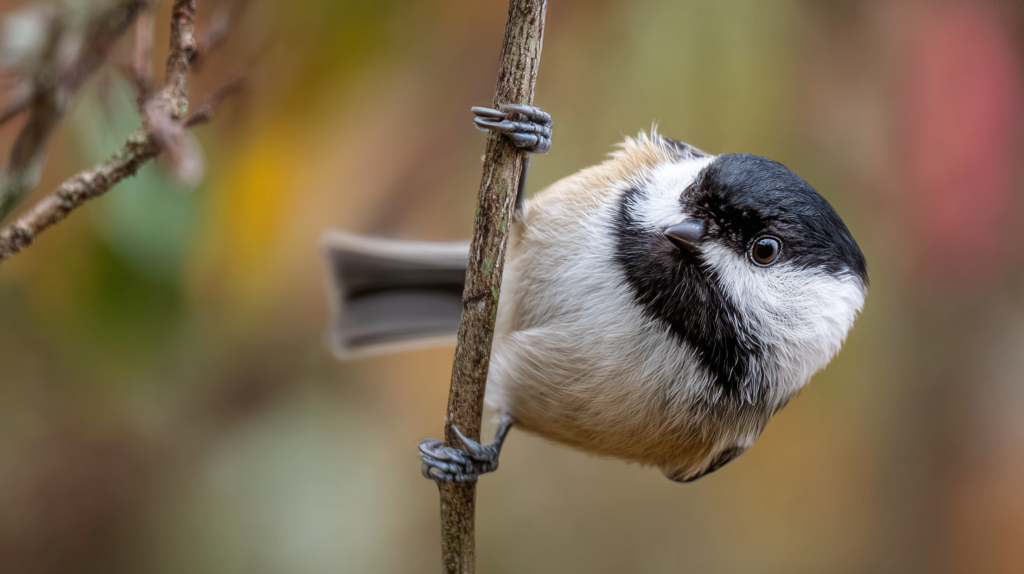
1. Black-capped Chickadee: The Friendly Acrobat
Identification Features
The Black-capped Chickadee ,Poecile atricapillus, is a small songbird with a distinctive appearance:
- Small round body (4.7-5.9 inches)
- Black cap and bib
- White cheeks
- Gray back and wings
- Whitish underparts with buffy sides
- Short, rounded bill
Behavior and Habitat
These energetic little birds are common across northern North America and are known for their:
- Acrobatic feeding style, often hanging upside-down from branches
- Bold, curious personality – often the first birds to investigate new feeders
- Distinctive “chickadee-dee-dee” call (with more “dees” indicating higher threat levels)
- Year-round residency in most areas
Attracting Chickadees to Your Yard
Chickadees are relatively easy to attract with:
- Black oil sunflower seeds (their favorite)
- Suet feeders, especially in winter
- Tube or platform feeders
- Nest boxes with 1⅛-inch entrance holes
- Native trees and shrubs that provide natural food sources
A 2023 study by the National Audubon Society found that chickadees visited backyards with diverse native plantings approximately 37% more frequently than yards with primarily non-native ornamental species.
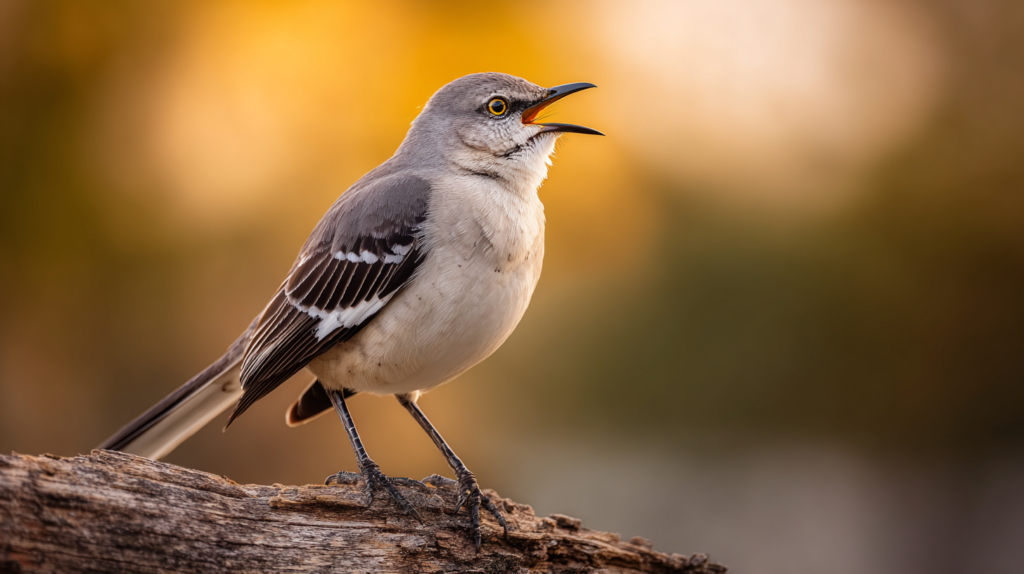
2. Northern Mockingbird: The Talented Mimic
Identification Features
The Northern Mockingbird (Mimus polyglottos) displays a more subtle black and white pattern:
- Medium-sized bird (8-11 inches)
- Gray upper parts
- Whitish-gray underparts
- Distinctive white wing patches visible in flight
- Long tail with white outer feathers
- Thin, slightly curved bill
Behavior and Habitat
These vocal virtuosos are found throughout the United States, southern Canada, and Mexico:
- Famous for mimicking other birds’ songs and environmental sounds
- Can learn up to 200 different songs in a lifetime
- Often sing at night, especially during spring and summer
- Fiercely territorial, particularly during breeding season
- Year-round residents in most of their range
Attracting Mockingbirds to Your Yard
To welcome these talented musicians:
- Plant fruit-bearing shrubs and trees like holly, hawthorn, and mulberry
- Provide a birdbath or shallow water source
- Create open lawn areas for ground feeding
- Maintain brushy areas for nesting sites
- Plant dense shrubs for protective cover
“Mockingbirds are remarkably adaptable to suburban environments,” notes wildlife biologist James Peterson. “They’ve learned to incorporate car alarms, cell phone rings, and other urban sounds into their repertoire, making them true soundscape artists of our neighborhoods.”
3. Downy Woodpecker: The Petite Drummer

Identification Features
The Downy Woodpecker (Picoides pubescens) is North America’s smallest woodpecker:
- Small size (5.5-6.7 inches)
- Black back with white central stripe
- White belly and outer tail feathers
- Black wings with white spots
- Black crown and stripe through eye
- Males have a small red patch on back of head
- Short bill compared to other woodpeckers
Behavior and Habitat
These industrious birds are common across most of North America:
- Frequent visitors to backyard feeders and wooded areas
- Create distinctive drumming sounds on hollow trees and occasionally metal objects
- Forage by hitching up and down tree trunks in search of insects
- Often join mixed-species feeding flocks in winter
- Year-round residents in most areas
Attracting Downy Woodpeckers to Your Yard
These small woodpeckers are relatively easy to attract:
- Suet feeders (especially in winter)
- Black oil sunflower seeds
- Peanut butter
- Peanuts
- Dead trees or snags (if safe to leave standing)
- Woodpecker-specific nest boxes
A Cornell Lab of Ornithology study found that Downy Woodpeckers visited yards with suet feeders 64% more frequently than yards without them during winter months.
4. Eastern Kingbird: The Fierce Defender
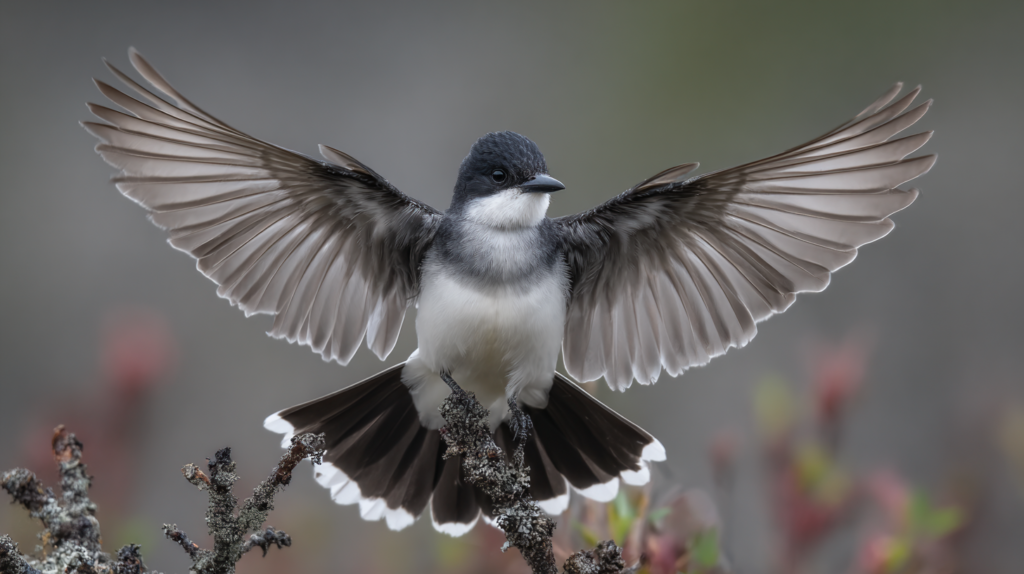
Identification Features
The Eastern Kingbird (Tyrannus tyrannus) displays classic black and white contrast:
- Medium-sized flycatcher (7.5-9 inches)
- Dark gray or black upperparts
- Clean white underparts
- Squared-off tail with distinctive white tip
- Slight crest on head
- Strong, straight bill
Behavior and Habitat
These summer visitors bring drama to backyards across eastern and central North America:
- Highly territorial, known to chase much larger birds like hawks and crows
- Often perch prominently on exposed branches or wires
- Catch insects in midair with acrobatic flights
- Make harsh, buzzing calls
- Migratory, spending winters in South America
Attracting Eastern Kingbirds to Your Yard
Although not typical feeder visitors, you can attract Eastern Kingbirds by:
- Maintaining open areas with scattered trees
- Planting native fruit-bearing trees and shrubs
- Creating naturalized areas that attract flying insects
- Installing birdbaths or other water features
- Avoiding pesticide use to maintain healthy insect populations
“Eastern Kingbirds are excellent biological control agents in gardens,” explains entomologist Dr. Sarah Wright. “A single kingbird family can consume thousands of flying insects during a summer season, including many garden pests.”
5. Black-billed Magpie: The Intelligent Conversationalist
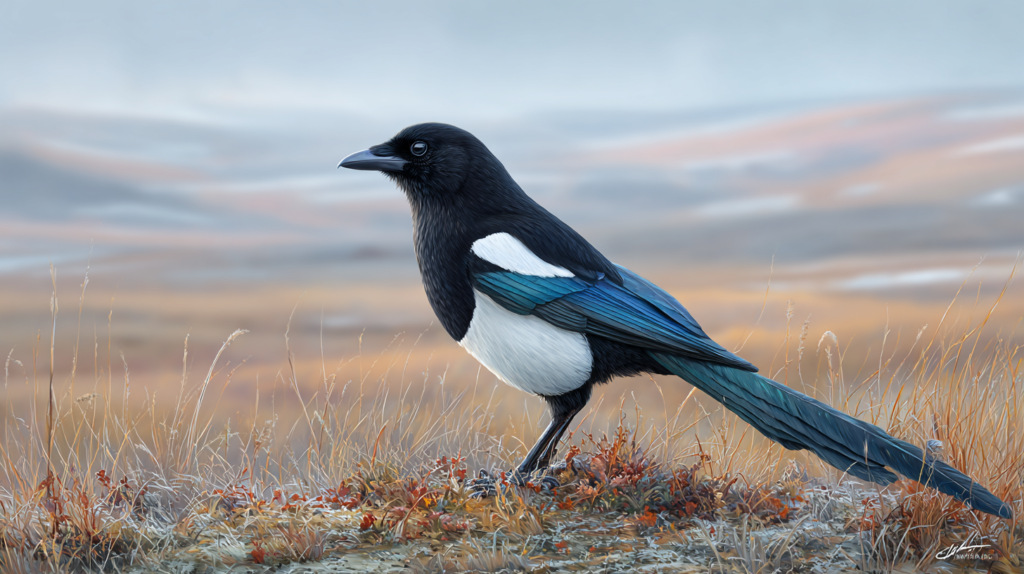
Identification Features
The Black-billed Magpie (Pica hudsonia) is one of North America’s most striking black and white birds:
- Large bird (18-24 inches, including tail)
- Black head, chest, back, and tail with iridescent blue-green sheen
- White belly and shoulder patches
- Extraordinarily long tail (often half their total length)
- Strong, slightly curved bill
- Noisy and conspicuous
Behavior and Habitat
These intelligent members of the crow family are found primarily in western North America:
- Highly social, often gathering in small groups
- Known for complex vocalizations and “conversations”
- Cache food for later consumption
- Build large, domed nests in trees
- Year-round residents in their range
- Omnivorous diet including insects, carrion, seeds, and small animals
Attracting Magpies to Your Yard
If you live within their range, you can attract these charismatic birds by:
- Providing platform feeders with suet, peanuts, or scraps
- Maintaining open areas with scattered trees
- Installing a ground-level birdbath or water feature
- Planting native fruit-bearing trees and shrubs
- Creating brush piles for foraging opportunities
“Magpies are among our most intelligent native birds,” says ornithologist Dr. John Marzluff. “They can recognize individual human faces and remember people who have been kind or threatening to them for years.”
6. Dark-eyed Junco: The Winter Visitor
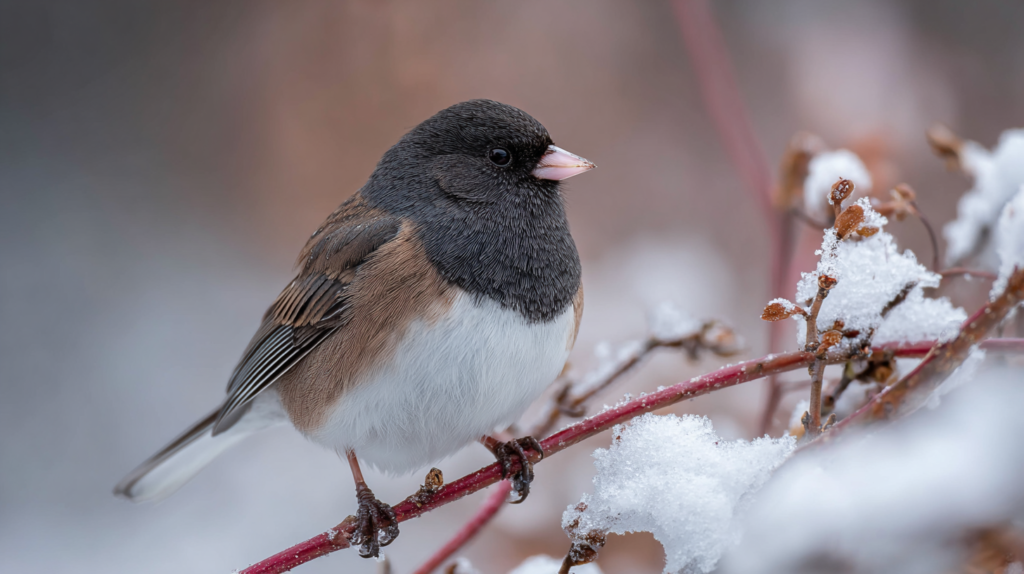
Identification Features
The Dark-eyed Junco (Junco hyemalis) comes in several regional varieties, but the “Slate-colored” form is most common:
- Small sparrow (5.5-6.3 inches)
- Dark gray or blackish hood and upper parts
- Crisp white belly
- Pink bill
- White outer tail feathers visible in flight
- Round body shape
Behavior and Habitat
These charming birds are winter visitors for many North American backyard birders:
- Often seen hopping on the ground under feeders
- Travel in small flocks during winter
- Make a light twittering call and a sharp “chip” note
- Breed in northern forests or mountains but winter widely across the continent
- Often called “snowbirds” as they arrive with cold weather
Attracting Juncos to Your Yard
To welcome these winter visitors:
- Scatter millet, cracked corn, or black oil sunflower seeds on the ground
- Use low platform feeders
- Maintain brushy edges and conifer trees for shelter
- Leave leaf litter in garden beds for foraging opportunities
- Provide fresh water sources that don’t freeze
Research from Project FeederWatch indicates that juncos visit over 80% of backyard feeding stations across North America during winter months, making them one of the most ubiquitous black and white birds in suburban environments.
7. Black-and-white Warbler: The Tree Creeper
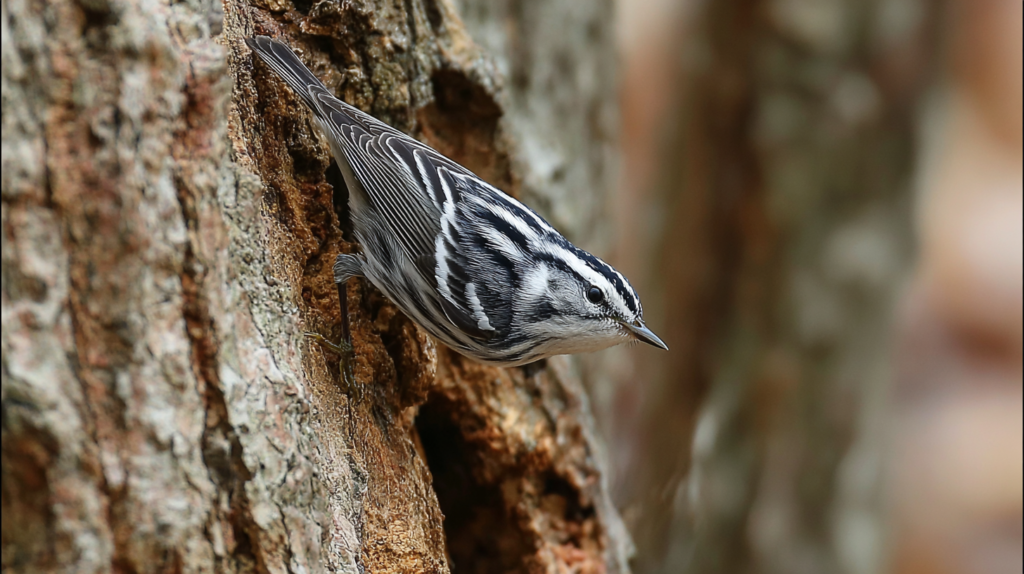
Identification Features
The Black-and-white Warbler (Mniotilta varia) features the most literal black and white pattern:
- Small warbler (4.3-5.1 inches)
- Boldly striped in black and white throughout
- Black crown with white median stripe
- Striped back and underparts
- Thin, slightly curved bill
- Males have darker black stripes than females
Behavior and Habitat
These distinctive warblers are summer visitors across eastern North America:
- Creep along tree trunks and branches like nuthatches
- Forage for insects in bark crevices
- Make a high, thin “wee-see” song
- Nest on the ground despite their tree-foraging habits
- Migrate to Central America and the Caribbean for winter
Attracting Black-and-white Warblers to Your Yard
These specialized insectivores rarely visit feeders but can be attracted by:
- Maintaining mature trees, especially oaks and maples
- Creating diverse forest layers with understory shrubs
- Eliminating pesticide use to ensure insect availability
- Providing moving water features like drip fountains
- Planting native flowering plants that attract insects
“Black-and-white Warblers are indicators of a healthy yard ecosystem,” explains ecologist Dr. Margaret Sloan. “Their presence suggests your property has enough insect diversity to support specialized feeders.”
8. White-breasted Nuthatch: The Upside-Down Specialist
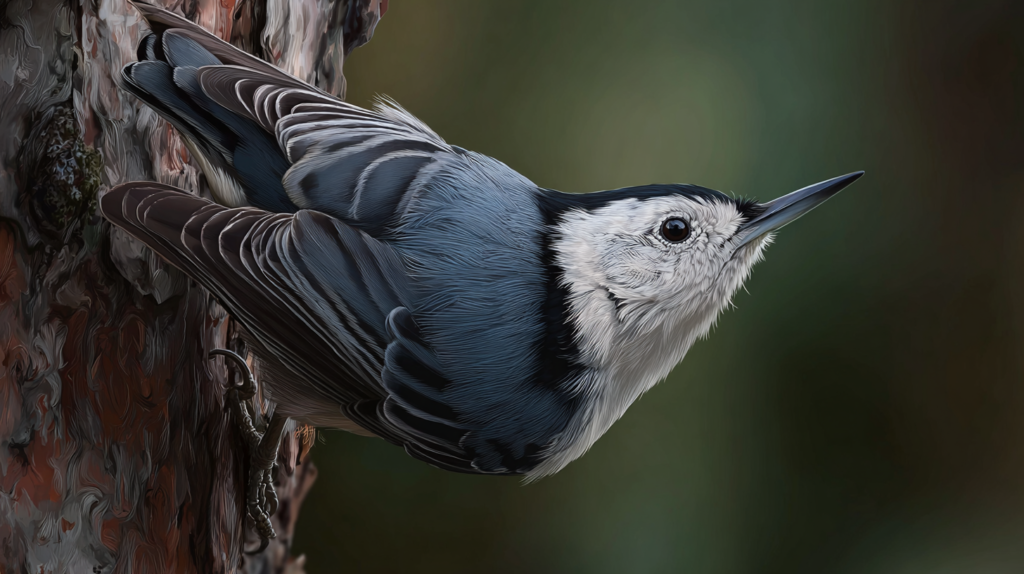
Identification Features
The White-breasted Nuthatch (Sitta carolinensis) offers a distinctive silhouette:
- Small, compact bird (5.1-5.9 inches)
- Bluish-gray back
- Black cap (males) or dark gray cap (females)
- White face and underparts
- Chestnut coloration under tail
- Short tail and powerful bill
- Strong feet for climbing
Behavior and Habitat
These energetic birds are year-round residents throughout most of the United States:
- Famous for climbing headfirst down tree trunks
- Make a nasal “yank-yank” call
- Store seeds by wedging them into bark crevices
- Often travel with chickadees in mixed winter flocks
- Highly territorial during breeding season
Attracting White-breasted Nuthatches to Your Yard
These charming birds are relatively easy to attract:
- Offer black oil sunflower seeds, peanuts, and suet
- Use feeders attached to tree trunks
- Maintain mature trees, especially oaks
- Provide nesting boxes with 1¼-inch entrance holes
- Leave dead branches (when safe) for foraging opportunities
A 2022 study published in the Journal of Ornithology found that properties with at least three large hardwood trees (>60 feet tall) were four times more likely to attract nesting White-breasted Nuthatches than similar properties without mature trees.
9. Hairy Woodpecker: The Downy’s Larger Cousin
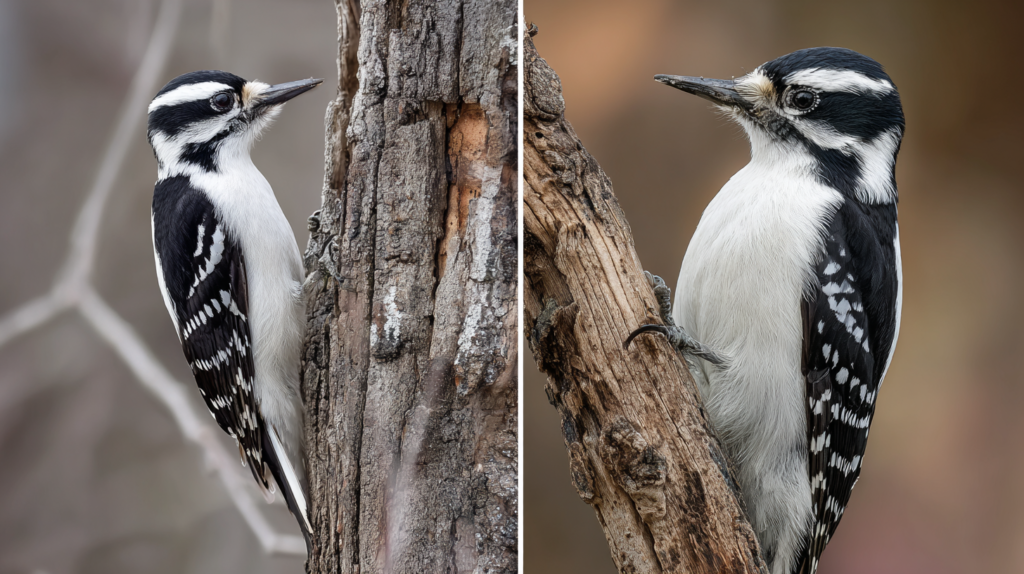
Identification Features
The Hairy Woodpecker (Leuconotopicus villosus) looks very similar to the Downy but with key differences:
- Medium-sized woodpecker (7.1-10.2 inches)
- Black back with white central stripe
- White belly and outer tail feathers
- Black wings with white spots
- Black crown and stripe through eye
- Males have a red patch on back of head
- Notably larger bill than the Downy Woodpecker
- Overall larger size than Downy
Behavior and Habitat
These powerful woodpeckers are found across much of North America:
- Prefer more mature forests than Downies
- Make louder drumming sounds and higher-pitched calls
- Excavate deeper into wood for insects and larvae
- Less likely to visit feeders than Downy Woodpeckers
- Year-round residents in most areas
Attracting Hairy Woodpeckers to Your Yard
To encourage these impressive birds:
- Offer suet, especially in winter
- Provide peanuts and black oil sunflower seeds
- Install woodpecker-specific nest boxes
- Maintain mature trees when possible
- Create dead snags (if safe to do so)
“The presence of both Downy and Hairy Woodpeckers in a yard indicates a healthy ecosystem with insect diversity across different wood layers,” notes wildlife rehabilitator Karen Thompson. “Together, they occupy different niches, with Hairy Woodpeckers typically foraging on larger branches and trunks.”
How to Create a Black and White Bird Haven
Now that you’re familiar with these striking black and white birds, here are some comprehensive strategies to make your backyard more attractive to them:
Food Sources for Black and White Birds
Different black and white birds have different feeding preferences:
| Bird Species | Primary Foods | Recommended Feeder Types |
| Black-capped Chickadee | Sunflower seeds, suet, peanuts | Tube feeders, suet cages |
| Northern Mockingbird | Berries, fruits, insects | Platform feeders, native plantings |
| Downy Woodpecker | Insects, suet, sunflower seeds | Suet cages, tube feeders |
| Eastern Kingbird | Flying insects | No feeders – natural insect populations |
| Black-billed Magpie | Omnivorous – seeds, fruits, insects, scraps | Platform feeders |
| Dark-eyed Junco | Small seeds, millet | Ground or platform feeders |
| Black-and-white Warbler | Insects, particularly bark-dwelling | No feeders – natural insect populations |
| White-breasted Nuthatch | Sunflower seeds, peanuts, suet | Tube feeders, suet cages |
| Hairy Woodpecker | Insects, suet, peanuts | Suet cages, sturdy tube feeders |
Water Features That Attract Black and White Birds
Water is essential for all bird species:
- Bird baths: Place at different heights to accommodate different species
- Moving water: Drippers or small fountains create noise that attracts birds
- Shallow areas: Ensure some parts are only 1-2 inches deep for smaller birds
- Winter heating: Heated bird baths in colder climates maintain access during freezing weather
- Natural features: Small garden ponds with shallow edges
Native Plants That Support Black and White Birds
Native plants provide food, shelter, and nesting sites:
- Oak trees: Support hundreds of insect species that feed woodpeckers, nuthatches, and warblers
- Serviceberry: Produces berries enjoyed by mockingbirds and magpies
- Dogwoods: Provide both berries and attract insects
- Sunflowers: Seeds beloved by chickadees and nuthatches
- Elderberry: Produces berries for mockingbirds
- Conifers: Provide winter shelter and foraging for juncos and chickadees
A National Wildlife Federation study found that yards with at least 70% native plant coverage attracted three times more bird species than yards dominated by non-native ornamentals.
Creating Safe Habitat Structure
Birds need appropriate spaces for different activities:
- Varied vegetation heights: Different black and white bird species prefer different levels
- Brush piles: Provide shelter for juncos and other ground feeders
- Dead trees: When safe, provide essential habitat for woodpeckers
- Dense shrubs: Offer nesting sites for mockingbirds and protection for smaller birds
- Open areas: Required by ground feeders like juncos and kingbirds for foraging
Seasonal Patterns of Black and White Birds
Understanding when you might see particular black and white birds can enhance your birdwatching experience:
Spring
- Black-and-white Warblers return from migration
- Eastern Kingbirds arrive from South America
- Mockingbirds become more territorial and vocal
- Woodpeckers and chickadees establish breeding territories
Summer
- Eastern Kingbirds actively feeding young
- Mockingbirds continue singing, sometimes all night
- Black-and-white Warblers quietly foraging in mature trees
- Woodpeckers bringing insects to nest holes
Fall
- Dark-eyed Juncos begin to arrive from northern breeding grounds
- Black-and-white Warblers migrate south
- Eastern Kingbirds gather in flocks before migration
- Magpies become more social, forming small groups
Winter
- Chickadees form mixed flocks with nuthatches and woodpeckers
- Dark-eyed Juncos forage in groups under feeders
- Mockingbirds defend berry-producing shrubs
- Woodpeckers visit suet feeders more frequently
Conservation Considerations for Black and White Birds
Many black and white bird species face challenges in modern environments:
- Habitat loss: Urbanization and forest fragmentation impact breeding sites
- Climate change: Shifting seasons affect migration timing and food availability
- Pesticides: Reduce insect populations critical for many species
- Window collisions: Cause millions of bird deaths annually
- Predation by cats: Free-roaming cats kill billions of birds yearly in North America
How You Can Help
Simple actions can make your yard part of the solution:
- Window treatments: Apply decals or screens to prevent collisions
- Keep cats indoors: Or provide outdoor enclosures (catios)
- Reduce pesticide use: Maintain natural insect populations
- Support bird-friendly legislation: Such as the Migratory Bird Protection Act
- Participate in community science: Report your bird sightings to projects like eBird
Individual yards may seem small, but collectively they represent a significant habitat resource,” explains Audubon Society conservation director Dr. Emma Richards. When homeowners manage their properties with birds in mind, they create crucial stepping stones between larger natural areas.
Special Tips for Photographing Black and White Birds
For those interested in capturing images of these striking birds:
- Exposure challenges: The contrast between black and white areas requires careful exposure
- Early morning light: Provides the best illumination for showing detail in both dark and light areas
- Background considerations: Clean backgrounds help the black and white patterns stand out
- Patience is key: Learn each species’ behavior patterns to anticipate movement
- Focus on the eye: Sharp focus on the bird’s eye is essential for compelling photographs
Wildlife photographer Michael Thompson advises: “When photographing black and white birds, I often underexpose slightly to prevent the white areas from ‘blowing out.’ It’s easier to recover detail from slightly dark areas than from overexposed whites.”
How to Keep a Black and White Bird Journal
Maintaining a journal of your black and white bird observations can enhance your connection with these species:
- Record first sightings: Note when each species first appears in your yard
- Behavior observations: Document interesting behaviors or interactions
- Seasonal patterns: Track changes throughout the year
- Response to habitat changes: Note how birds respond to changes you make in your yard
- Include sketches or photos: Visual records help track identification skills improvement
For more expert pet care tips and product recommendations, visit BlithePet.com — your trusted source for pet wellness.
Frequently Asked Questions About Black and White Birds
What is the small black and white bird I see in my yard?
If you’re seeing a tiny black and white bird with a black cap and bib with white cheeks, it’s likely a Black-capped Chickadee. If it’s creeping along tree trunks and branches, often upside-down, it could be a White-breasted Nuthatch. For a bird with bold black and white stripes all over its body, you’re probably spotting a Black-and-white Warbler.
How can I tell the difference between a Downy and Hairy Woodpecker?
The key difference is size – Hairy Woodpeckers are notably larger (about 9 inches long compared to the Downy’s 6 inches). More importantly, the Hairy Woodpecker has a much longer, heavier bill – approximately equal to the length of its head. The Downy’s bill is short, about half the length of its head. Their markings are otherwise extremely similar.
Do black and white birds stay all year or migrate?
It depends on the species! Birds like Black-capped Chickadees, White-breasted Nuthatches, Downy and Hairy Woodpeckers, and Black-billed Magpies generally stay year-round in their territories. Eastern Kingbirds and Black-and-white Warblers are migratory, spending winters in Central and South America. Dark-eyed Juncos breed in northern forests but winter throughout much of North America.
What’s the best way to attract woodpeckers to my yard?
Woodpeckers are most reliably attracted with suet feeders, especially during winter months. They also appreciate black oil sunflower seeds, peanuts, and native trees that harbor insects. Leaving dead tree snags (when safe) provides natural foraging and potential nesting sites. Woodpecker-specific nest boxes can also attract some species during breeding season.
Are magpies related to crows?
Yes! Black-billed Magpies belong to the family Corvidae, which includes crows, ravens, and jays. Like their relatives, magpies are highly intelligent birds capable of complex problem-solving, tool use, and recognizing individual human faces. They’re known for their curiosity and adaptability to different environments.
Why do some black and white birds sing at night?
The Northern Mockingbird is famous for its nighttime singing, particularly unmated males during spring and early summer. They’re attempting to attract mates and may sing all night under bright moonlight or even artificial lighting. Their songs are complex mixtures of their own calls and imitations of other birds and environmental sounds.
Conclusion
The world of black and white birds brings drama and contrast to your backyard birdwatching experience. From the tiny, energetic Black-capped Chickadee to the impressive, long-tailed Black-billed Magpie, these monochromatic marvels offer endless opportunities for observation and appreciation. Their distinctive patterns make them easier to identify than many other bird groups, making them perfect “gateway birds” for beginning birders.
By providing appropriate food sources, water features, and native plants, you can transform your yard into a haven for these striking birds. Each species brings its own unique behaviors and ecological role, contributing to the health and diversity of your local environment. Whether you’re watching a White-breasted Nuthatch inching headfirst down a tree trunk or listening to a Northern Mockingbird’s varied repertoire, black and white birds offer some of nature’s most accessible and rewarding wildlife experiences.
Have a similar experience with black and white birds in your backyard? Share it in the comments below!

